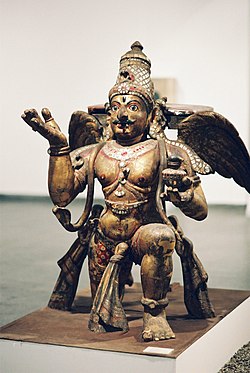Garuda
Garuda (v sanskrtu गरुड़, Garuḍa, páli: गरुळ, Garuḷa) je legendární pták respektive ptačí bytost v hinduistické, buddhistické a džinistické mytologii.[1][2][3] V hinduismu je Višnuovým jízdním zvířetem (váhanou), v buddhistické tradici působí jako Dharmapála – ochránce dharmy a v džinismu je jakšou (polobohem) spojeným s 16. tírthankarou jménem Šántinátha.[2][3][1]
Garuda je popisován jako „král ptáků“ a bývá ztotožňován s luňákem brahmínským.[4][5] Je zobrazován buď ve zvířecí podobě jako obrovský pták s částečně roztaženými křídly a nebo v lidské podobě jako muž s křídly a ptačími rysy. Garuda je obecně považován za bedlivého ochránce, který může přispěchat kamkoliv na pomoc a za nepřítele nágů.[5] V některých dílech je znám jako Tárkšja (तार्क्ष्य) a nebo Vainatéja (वैनतेय).[2]
Odkaz
Garuda je součástí státního znaku Indonésie a Thajska. Dále jej užívá ve svém znaku mongolské hlavní město Ulánbátar.[6] Dal také název operačnímu systému Garuda Linux. Vlajková letecká společnost Indonésie nese název Garuda Indonesia a v roce 2024 byla dokončena výstavba prezidentského paláce, zdobeného ocelovou konstrukcí ve tvaru křídel, v plánovaném novém hlavním městě Indonésie Nusantaře.[7]
Galerie
- Dřevěná socha Garudy, národní muzeum v Novém Dillí
- Luňák brahmínský, v hinduismu tradiční zvířecí podoba Garudy
- Garuda nesoucí Šivu na obraze Rádži Ravi Varmy, ca 1910
- Garuda s nágy na reliéfu, chrám v kambodžském Angkoru
- Garuda ve znaku města Ulánbátar
Odkazy
Reference
V tomto článku byl použit překlad textu z článku Garuda na anglické Wikipedii.
- ↑ a b BUSWELL JR., Robert E.; LOPEZ JR., Donald S. The Princeton Dictionary of Buddhism. Princeton: Princeton University Press, 2013. ISBN 978-1-4008-4805-8. S. 314–315. (anglicky)
- ↑ a b c DALAL, Roshen. Hinduism: An Alphabetical Guide. New Delhi: Penguin Books, 2010. Dostupné online. ISBN 978-0-14-341421-6. S. 145. (anglicky)
- ↑ a b GLASENAPP, Helmuth von. Jainism: An Indian Religion of Salvation. Delhi: Motilal Banarsidass, 1999. ISBN 978-81-208-1376-2. S. 532. (anglicky)
- ↑ WILLIAMS, George M. Handbook of Hindu Mythology. New York: Oxford University Press, 2008. Dostupné online. ISBN 978-0-19-533261-2. S. 138–139. (anglicky)
- ↑ a b GOPINATHA RAO, T. A. Elements of Hindu iconography. Madras: Law Printing House, 1914. Dostupné online. S. 283–285. (anglicky)
- ↑ KOHN, Michael. Lonely Planet Mongolia. Melbourne: Lonely Planet Publications, 2005. ISBN 9781740593595. S. 52. (anglicky)
- ↑ SUHENDA, Dio. Nusantara presidential palace completed in time for Independence Day. The Jakarta Post [online]. 2024-07-23. Dostupné online. (anglicky)
Externí odkazy
 Obrázky, zvuky či videa k tématu Garuda na Wikimedia Commons
Obrázky, zvuky či videa k tématu Garuda na Wikimedia Commons
Média použitá na této stránce
Coat of arms of Ulaanbaatar, capital of Mongolia.
Adopted by Citizens' Representatives Khural of the Capital City in 1995. The coat of arms of the capital of Mongolia is Khandardi (Garuda), the deity of Bogd khan mountain, which is placed in the center of the shield shaped circle.
- Khangardi has a Soyombo symbol on his forehead, a symbol of statehood and knowledge.
- In his right hand, he holds a vajra-bow key, which represents opening the gates to its people and ever continuing development.
- In his left hand, he cherishes the lotus flower, which symbolizes pureness and a tranquil existence without suffering,
- Trampling a snake under his feet represents the demolishing of the roots of evil.
- Representing stability and courage, the Khangardi symbolizes the city’s great expansion and its glory throughout the world.
Autor: Koshy Koshy from Faridabad, Haryana, India, Licence: CC BY 2.0
A Brahminy Kite near Cherai Beach, Kochi, Kerala, India.
State emblem of Indonesia is called Garuda Pancasila. The main part of the coat of arms is the golden mythical bird Garuda with a shield on its chest and a scroll gripped by its leg bears the national motto: "Bhinneka Tunggal Ika", roughly means "Unity in Diversity". The shield's five emblems represent Pancasila, the five principles of Indonesia's national philosophy. The numbers of feathers was meant to symbolize the date of Indonesian Proclamation of Independence; 17 feathers on each wings, 8 tail feathers, 19 upper tail feathers (under the shield, above the tail), and 45 neck feathers; all symbolize 17-8-1945; 17th August 1945. Garuda Pancasila was designed by Sultan Hamid II of Pontianak, and was adopted as national coat of arms on February 11, 1950.
National Emblem of Thailand, depicting a dancing Garuda with outstretched wings. The Garuda symbolizes the government and people of Thailand, as Lord Vishnu symbolizes King of Thailand.
Autor: Hyougushi / Hideyuki KAMON from National Museum in Delhi, India, Licence: CC BY-SA 2.0
ガルダ (Garuda) は、インド神話に登場する神鳥で、ヴィシュヌ神の乗り物。佛教では八部衆(二十八部衆)の迦楼羅(かるら)にあたります。ちなみに、ガルーダ・インドネシア航空の「ガルーダ」も元を辿れば彼(?)です。
(2005/01/22 National Museum, Delhi, INDIA)
Who are you?
Autor: Jean-Pierre Dalbéra from Paris, France, Licence: CC BY 2.0
Garuda sur le mur d'enceinte extérieure de Preah Khan
________________ Preah Khan (ou Prah Khan) est un temple construit sous le règne de Jayavarman VII (1181-1218), Il est consacré au culte bouddhique du Mahâyâna. Il a été inauguré en 1191. Preah Khan signifie "Epée sacrée", son nom d'origine est "capitale de la victoire" car il est construit sur le lieu de la bataille victorieuse des khmers contre les chams.
Il est entouré d'une enceinte rectangulaire en latérite de 800 m sur 700 m, bordée de douves de 50 m.
Les chaussées-digues, qui mènent aux bâtiments d'entrée : les gopura, sont ornées de géants gardiens, les bons Yaksha à gauche (Deva) et les mauvais Yaksha à droite (Asura). Ces derniers tiennent le serpent-Nâga qui sert de balustrade.
Les représentations de Bouddha en méditation ont été buchées au XIIIè siècle par des fanatiques hindouistes.
La tour-sanctuaire centrale abritait la statue du dieu bouddhiste Lokeshvara, en mémoire du père du roi. Les hindouistes auraient remplacé cette statue par un linga,












